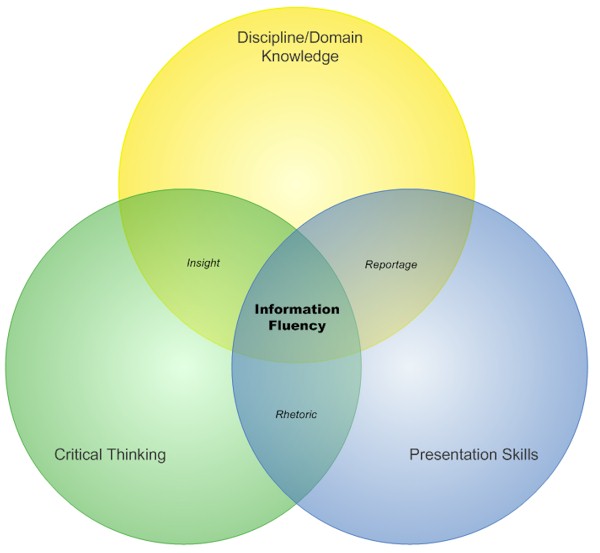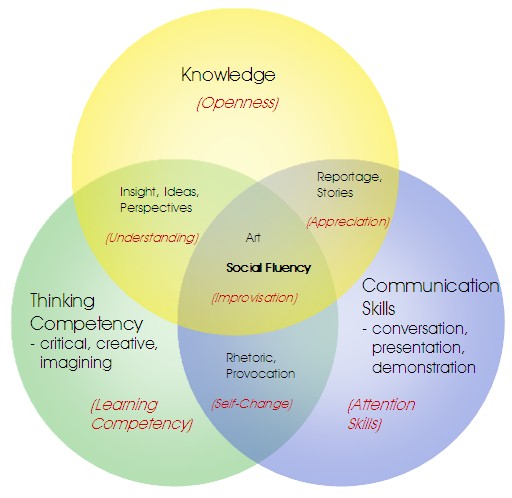| A repost of an article from one year ago
After Nancy White pointed me to Chris Lott’s articles on Northern Voice, and on love, and Chris replied to my Tuesday post on how easily we unintentionally hurt each other through our actions, I did a bit more research on Chris’ work and discovered the remarkable chart above on Information Fluency. Chris put this together a couple of years ago for an IT audience and has since expanded on it, but for me it produced an immediate aha! Our professional ‘value’ really is a function of the extent of, and our ability to integrate, our knowledge, our thinking competencies, and our communication competencies. Insight depends on our ability to apply critical thinking to what we know. Reportage is the application of our communication skills to what we know. Rhetoric is the articulation of our thinking. And the ability to do all of these things in an integral way is what Chris calls ‘information fluency’. I think this is brilliant, and it got me thinking about how this model could be broadened to represent our social fluency — our ability to function socially in the modern complex world, to be of use socially to others in our communities. The chart below is what I came up with.
In thinking about this further and reading Nancy White’s blog, I realized that what was missing from the model was learning. I realized that the model was from the perspective of the actor (presenter, demonstrator, creator, artist) and not the perspective of the reactor (audience, listener, student, learner). It occurred to me that since social activity is like a dance, there should be a ‘mirror’ set of attributes for effective response-ability (responsibility). My first cut at these is in red brackets above:
What’s interesting to me about this is that some people are terrific artists (they re-present reality well, as professors, writers, presenters etc.) but not very good improvisers (they are antisocial or not open to new ideas and new learning). This is a terrible shame — such people are underskilled for a peer-to-peer world where social exchange is two-way. Likewise, there are some great improvisers (people who have learned a great deal) who are unskilled at expressing that learning, ‘passing it on’. It would be interesting to see a social network map that depicted individuals not just as dots (nodes) but with their six circles. This could show what people value in others in their networks/communities, and what they offer, and how that effects both their ‘popularity’ and the strength of the community as a whole. So what can we do, as individuals, to improve our social fluency — to become better artists and improvisers? I think the first step is self-knowledge — to know what our strengths and weaknesses are in each of the six circles. And the second step is practice, with others who are both better and worse than we are at each. What do you think of this model? Have I overloaded it? Is it useful? Is it missing something? Where does presence fit into it? Where does love fit?. Category: Social Networking
|







Where’s asking useful (and not even necessarily THE right) questions in this model ?I’m assuming that you’re assuming they are subsumed in the characteristics of openness and skilled attention … which may or may not be the case, no ?I think that good questions can be a significant catalyst to creating and / or increasing shared social fluency between people, notably direct questions that cut to the essence of an issue without being inflammatory, pedantic, or threatening.Aakh, I’m probably being a pedantic arse again.
The model would need to be 3- or even 4-D, Dave, to get to the complexity you’re engaging with here.Thank you–